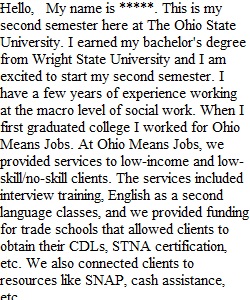


Q Class Discussion Overview Welcome to the Class Discussion area! This semester, we will be using the discussion forums as a way of continuing working together as a community online and communicating with each other about the class content. We will have opportunities to introduce ourselves, answer questions about the topic at hand, or even ask questions that could be addressed during the Live Class sessions we will be having (learn more about these in the Live Class Session area). We will also want to reference the coursework (articles, podcasts, other readings & activities) to support your discussion posts. To help us understand the expectations of our discussions this semester, below we will discuss the following areas: Introductions, Peer Exchange, Hidden Discussions, and Online Discussion Etiquette. Discussion Protocol & Peer Exchange Your discussion response should fully address the discussion prompt and be supported by materials from the course and reading requirements. Additionally, your posts should be 2-3 paragraphs (approximately 250-300 words), be grammatically correct, and follow APA guidelines for references and style. A peer exchange requires you to respond to another student's post. These exchanges should be thoughtful to receive full points. Responses such as “I agree” will not be considered a proper response. Points will be assigned as follows: 3 points - Quality and Relevance of Original Post 1 point - Peer Exchange ________________________________________ Hidden Discussions A hidden discussion indicates that you will not be able to view other student’s posts until after you have posted your original response. Once you have posted, then all of your student’s posts will appear. This will help keep all of your original topics authentic and original. ________________________________________ Online Discussion Etiquette It is important to understand that we need to respond to each other in a considerate and thoughtful manner. To help promote this positive interaction, please refer to the Online Discussion Etiquette document Download Online Discussion Etiquette document for a set of guidelines regarding your responses to each other. ________________________________________ Class Café We will have a non-graded Class Café area available that can be used throughout the semester. Please use this café area to ask general questions, share current events and/or breaking news, and share interesting links to information regarding our topics. This is not a requirement of the course, but a place where you can share information or ask questions if you like. You may access this area through the Class Discussion section (listed within the Activities tab above) or by selecting the following link: Class Café - General Discussion Area ________________________________________ Introduction Discussion: Directions: To begin this week, please introduce yourself to the class and share what experiences you have had with macro practice. In this post, please share ideas on organizations you know from placement or employment and begin to identify any concerns that you may have already seen. ________________________________________ Peer Exchange: Please respond respectfully and thoroughly to at least two of your peers.
View Related Questions